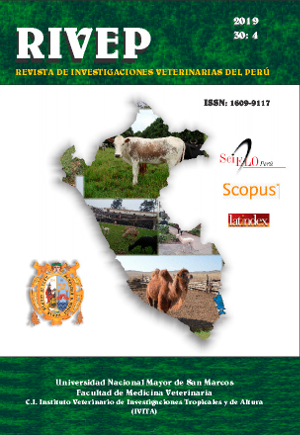Hormonal treatments applied after the FTAI on pregnancy rate and embryo viability in high-producing dairy cows under thermal stress
DOI:
https://doi.org/10.15381/rivep.v30i4.17191Keywords:
high-producing cows, GnRH, pregnancy rate, progesterone, corpus luteumAbstract
The aim of this study was to evaluate the effect of GnRH, hCG and eCG applied 14 days after fixed time artificial insemination (FTAI) on the rate of pregnancy and embryonic and foetal survival in cows under heat stress. The cows (n = 234) were synchronized, inseminated and received 14 days later via i.m. the hormonal application: a) Control group: 2 ml of saline solution (n=56), b) GnRH group: 100 µg of GnRH (n=58), Group c) hCG: 1500 IU of hCG (n=60), and d) ECG Group: 400 IU of eCG (n=60). The diagnosis of pregnancy and the evaluation of the number of corpora lutea (CL) was determined by ultrasonography on days 34, 45 and 60 of the AI. Cows treated with GnRH had a higher pregnancy rate (p<0.05) and no significant differences were found between the other groups. Embryonic and foetal survival between days 45 and 60 was constant in all groups, but one foetal death occurred in the eCG group. There were no significant differences in the proportion of accessory CL between the treated groups and the control group at 60 days of gestation. It is concluded that the administration of GnRH 14 days post-FTAI improves the pregnancy rate in dairy cows under caloric stress.
Downloads
Downloads
Published
Issue
Section
License
Copyright (c) 2020 Yusep Gómez Marín, José Goicochea Vargas, Wilson Rondón Jorge, Fidel Acosta Pachorro, Magaly Montalvo Martin, Marce Pérez Saavedra, Mauricio Silva Jiménez, Marcelo Ratto Fuster

This work is licensed under a Creative Commons Attribution-NonCommercial-ShareAlike 4.0 International License.
AUTHORS RETAIN THEIR RIGHTS:
a. Authors retain their trade mark rights and patent, and also on any process or procedure described in the article.
b. Authors retain their right to share, copy, distribute, perform and publicly communicate their article (eg, to place their article in an institutional repository or publish it in a book), with an acknowledgment of its initial publication in the Revista de Investigaciones Veterinarias del Perú (RIVEP).
c. Authors retain theirs right to make a subsequent publication of their work, to use the article or any part thereof (eg a compilation of his papers, lecture notes, thesis, or a book), always indicating the source of publication (the originator of the work, journal, volume, number and date).










